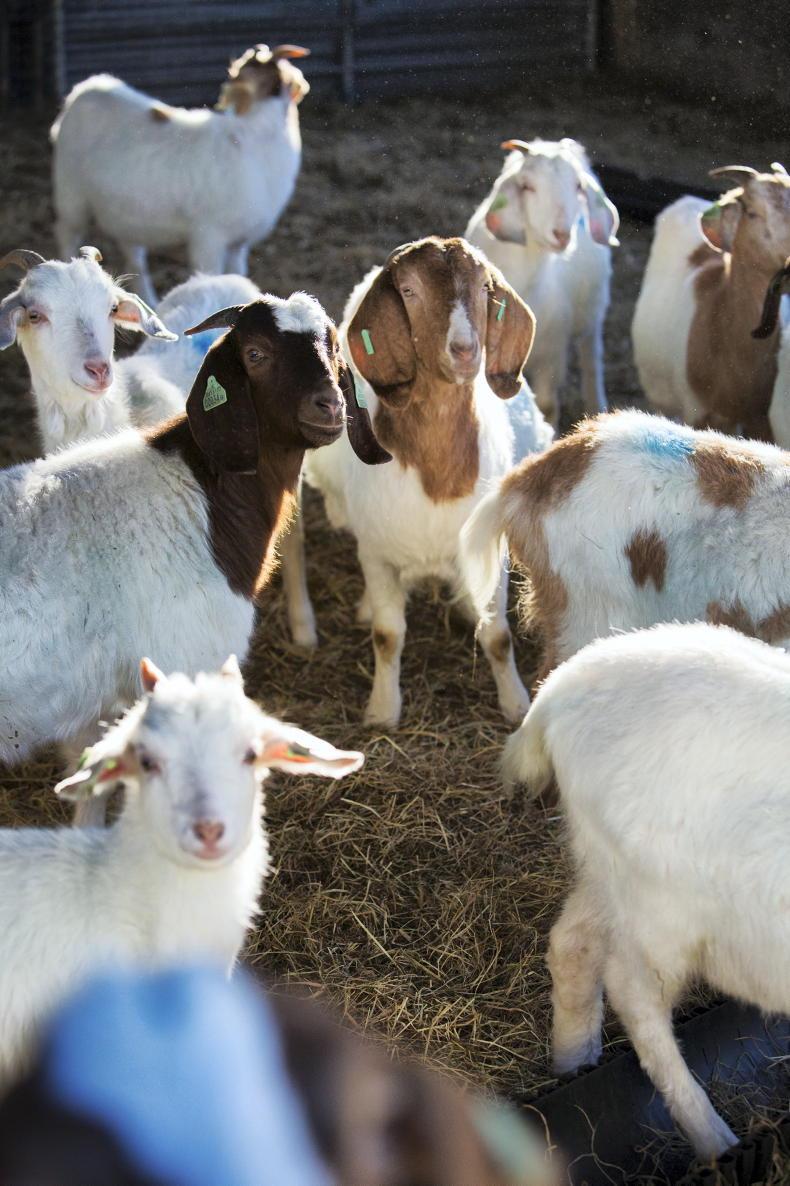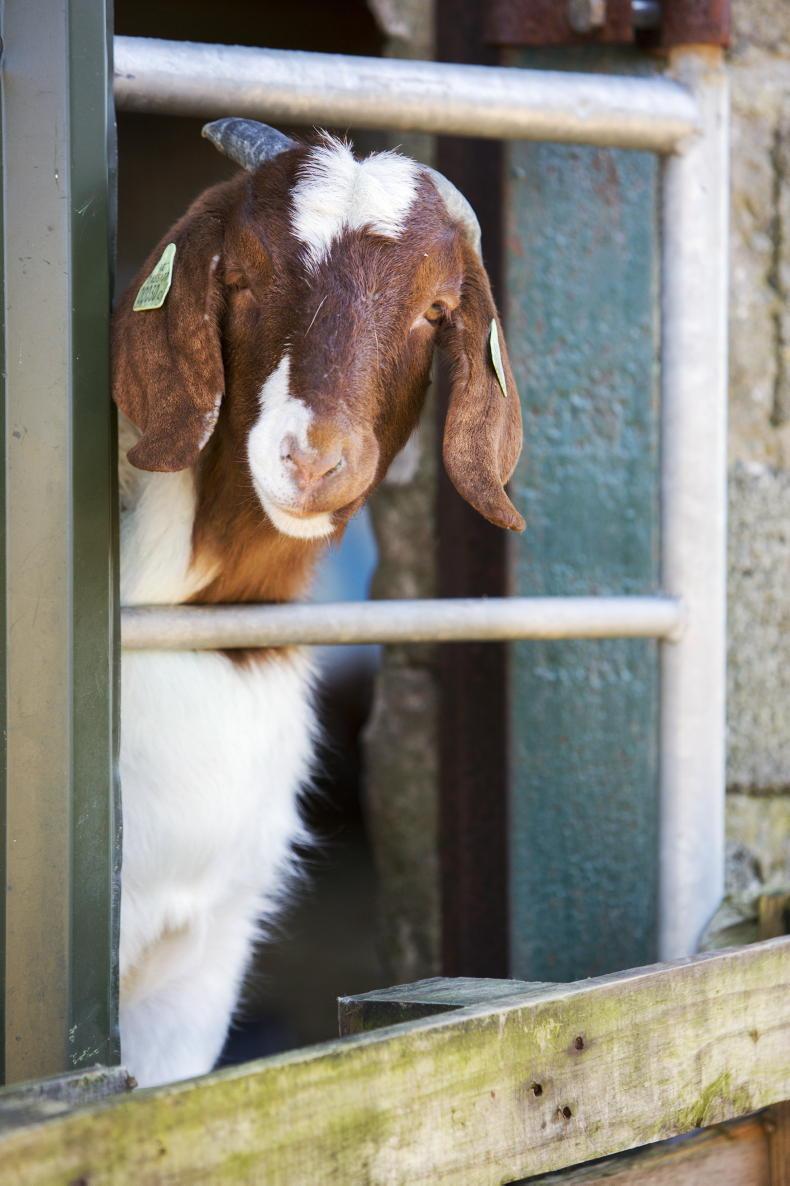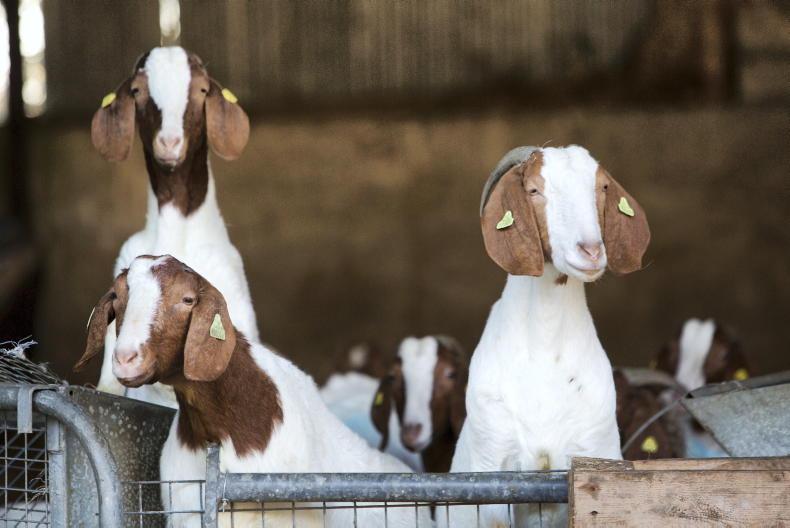It’s healthy, nutritious and tasty but why is it so hard to find goatmeat in our butchers or supermarket fridges? This is the question that led two transition-year students, Oscar Kingston and Samuel Mikulka from Clonakilty Community College to their project, ‘Why is goat off the menu?’
Goatmeat is widely consumed in a number of European countries, by ethnic populations and is a staple food in Africa, Asia and parts of the American continent. It may be suited to our methods of farming here in Ireland, as it can be produced on a grass-based system, similar to lamb.
With this in mind, Oscar and Samuel set out to investigate:
Why goatmeat is unpopular in Ireland.Why Irish farmers don’t produce goat meat.Why Irish consumers don’t opt for this healthy nutritious meat.Speaking to Irish Country Living, Oscar says: “Our project on goatmeat consumption in Ireland looked at the attitudes of both consumers and farmers, towards raising goats for meat. My family have been eating goatmeat for a few years now.

It is really nice; tastes quite like lamb, but leaner. I bought my first goat to rear for meat last year. We now have five does and a buck. So knowing that goatmeat is very healthy and tasty, we wanted to find out why it is not eaten in Ireland.”
The survey
As part of their analysis the pair circulated a survey, which received 500 responses.
“We were pleasantly surprised by the number of answers we received to our survey,” Oscar explains. “The results were quite unexpected, with almost 27% (133 people) saying they had eaten goatmeat; and 60 of those reported tasting the meat in Ireland, which was also higher than we expected.”
The detailed questionnaire also asked knowledge-based questions such as: “How many goat farms do you think exist in Ireland?”; “Where is goatmeat most popular?”; and “Do you know the percentages of fat and protein present in goatmeat?”
The students explain that many of these answers were incorrect, suggesting a large misconception towards farming and consuming goat meat in Ireland.

The students’ project also targeted farmers, with only three participating farmers having raised goats themselves. Assuming that most participating farmers did not raise goats, the survey asked: “Why not?”
“A large amount of people thought there was no market; that the time and management would be too large; and 9% of people felt they would be too troublesome to fence in.
“We feel this is down to the reputation they have gained as escape artists. We also found farmers were apprehensive, because they did not want to take the investment risk,” Oscar explains.
Nutrition and palatability
Goatmeat contains a high protein (26%) and low fat (3%) content.
Despite its huge nutritional value – the students’ survey results suggest that the majority of consumers are completely unaware of these percentages. In response to such misconception, Samuel and Oscar conclude that the low consumption of goatmeat in Ireland is largely due to misinformation and lack of knowledge.
“The majority of people who had tried goatmeat enjoyed the taste, proving that the flavour of the meat is not the problem – it is a case of misconception. We believe that because health awareness is so big now and Ireland is becoming a more ethnic country, there probably will be a larger market for goatmeat in the future, than what currently exists.”
Giving their final tuppence worth on the experience, Oscar and Samuel are passionate about further developing their research and awareness of goat meat consumption in Ireland,
“We were blown away by the number of people who had eaten goatmeat and enjoyed it. We would encourage people to get in touch with local farmers and express a demand for goat meat. Farmers aren’t going to take the risk, if nobody voices their interest. Government schemes for goat farm enterprises would also really encourage farmers over the ‘should we/shouldn’t we?’ border.
“We were hoping to do an awareness campaign about goat meat, but it is quite hard now. We couldn’t do taste testing or anything. But we definitely would like to do more research in this area in the future. It was a huge learning curve for both of us,” Samuel concludes.
When Paul and Ami Davis from Dunmore, Co Galway, started goat farming in 2017, they couldn’t have anticipated the journey it would take them on. Ami says: “It started out as farm diversification. We had a few sheep, but it wasn’t sustainable on its own. We could see there was a gap in the market for goatmeat for ethnic groups, and that has certainly proven true. But on top of that, there has been strong demand from Irish consumers, both from chefs and consumer trade.”
In 2017, they started out with 30 kid goats, last year they had 170 between their breeding herd and their bottle-fed kids. “For generations, goat farming has been a sustainable method of farming, using the meat of the dairy goat. Traditionally, families would have had goat for their Easter dinner. So we took the same approach.” While the Boer breed is most suitable for goatmeat, Paul and Ami worked with local goat dairy farmers to breed a cross of 50:50. “The optimum cross we are working towards is a third or fourth generation which is a 75% Boer cross. The goat would produce a good bit of meat with the yield of goatmeat to carcase at 60%.”
Not only did the Davis family start supplying Michelin-star chefs such as Jess Murphy in Kai Restaurant in Galway and Damien Grey in Liath Restaurant in Dublin, it was the online consumer demand that started them off on another interesting venture.
“As consumers were having a hard time sourcing goatmeat, we started packaging it to sell online. The consumer demand blew us away and was a very solid fall back for us when the pandemic hit and restaurants closed. We sell a 5kg box of goatmeat for €80 with free delivery.
“Each box contains a selection of cuts, both premium and household. For example, a 10kg (€150) box can contain two or three smaller roasts, a few kilos of diced meat and a mixture of some chops, ribs or mince.
“This amount of meat will take up about one shelf in a standard freezer. We really are seeing people being more creative with their cooking now that they have more time at home during the pandemic, whether its roasts or on the barbecue.”
Given the success of selling goat online, they have now diversified the business again into a meat wholesale business, providing other farmers with the opportunity to sell their meat direct. As well as goat boxes, their new website Valhalla Meats now does beef, lamb and wild game boxes as well as whole animal carcases for the barbecue.
valhallameats.com
– Ciara
Leahy
Traditionally in Ireland, and especially in the midlands, goat was served for Easter dinner instead of lamb.The best breed for goatmeat is the Boer but there are potential in other breeds such as the Kiko.Goatmeat has lower calories, fat, saturated fat and cholesterol than all other popular meats (including chicken) while having a comparable level of protein. These properties may lend themselves to the development of health-focussed added-value meat products, according to Teagasc.You may find it hard to find goatmeat recipes but if you find a good lamb or beef recipe, you can usually substitute in goatmeat. As it’s so low in fat, its usually best to slow cook it.The taste profile of goat depends on its ageing. Up to eight months, it’s sweet and good for soaking in flavour but as the animal matures, the taste becomes similar to lamb. Read more
Horticulture and grey water usage BTYS student projects: the expert's response
Milking goats on the Aran Island
It’s healthy, nutritious and tasty but why is it so hard to find goatmeat in our butchers or supermarket fridges? This is the question that led two transition-year students, Oscar Kingston and Samuel Mikulka from Clonakilty Community College to their project, ‘Why is goat off the menu?’
Goatmeat is widely consumed in a number of European countries, by ethnic populations and is a staple food in Africa, Asia and parts of the American continent. It may be suited to our methods of farming here in Ireland, as it can be produced on a grass-based system, similar to lamb.
With this in mind, Oscar and Samuel set out to investigate:
Why goatmeat is unpopular in Ireland.Why Irish farmers don’t produce goat meat.Why Irish consumers don’t opt for this healthy nutritious meat.Speaking to Irish Country Living, Oscar says: “Our project on goatmeat consumption in Ireland looked at the attitudes of both consumers and farmers, towards raising goats for meat. My family have been eating goatmeat for a few years now.

It is really nice; tastes quite like lamb, but leaner. I bought my first goat to rear for meat last year. We now have five does and a buck. So knowing that goatmeat is very healthy and tasty, we wanted to find out why it is not eaten in Ireland.”
The survey
As part of their analysis the pair circulated a survey, which received 500 responses.
“We were pleasantly surprised by the number of answers we received to our survey,” Oscar explains. “The results were quite unexpected, with almost 27% (133 people) saying they had eaten goatmeat; and 60 of those reported tasting the meat in Ireland, which was also higher than we expected.”
The detailed questionnaire also asked knowledge-based questions such as: “How many goat farms do you think exist in Ireland?”; “Where is goatmeat most popular?”; and “Do you know the percentages of fat and protein present in goatmeat?”
The students explain that many of these answers were incorrect, suggesting a large misconception towards farming and consuming goat meat in Ireland.

The students’ project also targeted farmers, with only three participating farmers having raised goats themselves. Assuming that most participating farmers did not raise goats, the survey asked: “Why not?”
“A large amount of people thought there was no market; that the time and management would be too large; and 9% of people felt they would be too troublesome to fence in.
“We feel this is down to the reputation they have gained as escape artists. We also found farmers were apprehensive, because they did not want to take the investment risk,” Oscar explains.
Nutrition and palatability
Goatmeat contains a high protein (26%) and low fat (3%) content.
Despite its huge nutritional value – the students’ survey results suggest that the majority of consumers are completely unaware of these percentages. In response to such misconception, Samuel and Oscar conclude that the low consumption of goatmeat in Ireland is largely due to misinformation and lack of knowledge.
“The majority of people who had tried goatmeat enjoyed the taste, proving that the flavour of the meat is not the problem – it is a case of misconception. We believe that because health awareness is so big now and Ireland is becoming a more ethnic country, there probably will be a larger market for goatmeat in the future, than what currently exists.”
Giving their final tuppence worth on the experience, Oscar and Samuel are passionate about further developing their research and awareness of goat meat consumption in Ireland,
“We were blown away by the number of people who had eaten goatmeat and enjoyed it. We would encourage people to get in touch with local farmers and express a demand for goat meat. Farmers aren’t going to take the risk, if nobody voices their interest. Government schemes for goat farm enterprises would also really encourage farmers over the ‘should we/shouldn’t we?’ border.
“We were hoping to do an awareness campaign about goat meat, but it is quite hard now. We couldn’t do taste testing or anything. But we definitely would like to do more research in this area in the future. It was a huge learning curve for both of us,” Samuel concludes.
When Paul and Ami Davis from Dunmore, Co Galway, started goat farming in 2017, they couldn’t have anticipated the journey it would take them on. Ami says: “It started out as farm diversification. We had a few sheep, but it wasn’t sustainable on its own. We could see there was a gap in the market for goatmeat for ethnic groups, and that has certainly proven true. But on top of that, there has been strong demand from Irish consumers, both from chefs and consumer trade.”
In 2017, they started out with 30 kid goats, last year they had 170 between their breeding herd and their bottle-fed kids. “For generations, goat farming has been a sustainable method of farming, using the meat of the dairy goat. Traditionally, families would have had goat for their Easter dinner. So we took the same approach.” While the Boer breed is most suitable for goatmeat, Paul and Ami worked with local goat dairy farmers to breed a cross of 50:50. “The optimum cross we are working towards is a third or fourth generation which is a 75% Boer cross. The goat would produce a good bit of meat with the yield of goatmeat to carcase at 60%.”
Not only did the Davis family start supplying Michelin-star chefs such as Jess Murphy in Kai Restaurant in Galway and Damien Grey in Liath Restaurant in Dublin, it was the online consumer demand that started them off on another interesting venture.
“As consumers were having a hard time sourcing goatmeat, we started packaging it to sell online. The consumer demand blew us away and was a very solid fall back for us when the pandemic hit and restaurants closed. We sell a 5kg box of goatmeat for €80 with free delivery.
“Each box contains a selection of cuts, both premium and household. For example, a 10kg (€150) box can contain two or three smaller roasts, a few kilos of diced meat and a mixture of some chops, ribs or mince.
“This amount of meat will take up about one shelf in a standard freezer. We really are seeing people being more creative with their cooking now that they have more time at home during the pandemic, whether its roasts or on the barbecue.”
Given the success of selling goat online, they have now diversified the business again into a meat wholesale business, providing other farmers with the opportunity to sell their meat direct. As well as goat boxes, their new website Valhalla Meats now does beef, lamb and wild game boxes as well as whole animal carcases for the barbecue.
valhallameats.com
– Ciara
Leahy
Traditionally in Ireland, and especially in the midlands, goat was served for Easter dinner instead of lamb.The best breed for goatmeat is the Boer but there are potential in other breeds such as the Kiko.Goatmeat has lower calories, fat, saturated fat and cholesterol than all other popular meats (including chicken) while having a comparable level of protein. These properties may lend themselves to the development of health-focussed added-value meat products, according to Teagasc.You may find it hard to find goatmeat recipes but if you find a good lamb or beef recipe, you can usually substitute in goatmeat. As it’s so low in fat, its usually best to slow cook it.The taste profile of goat depends on its ageing. Up to eight months, it’s sweet and good for soaking in flavour but as the animal matures, the taste becomes similar to lamb. Read more
Horticulture and grey water usage BTYS student projects: the expert's response
Milking goats on the Aran Island








 This is a subscriber-only article
This is a subscriber-only article






SHARING OPTIONS: